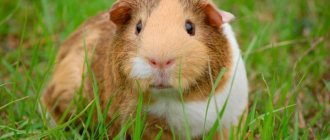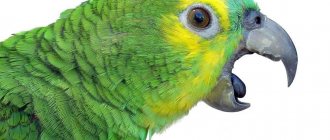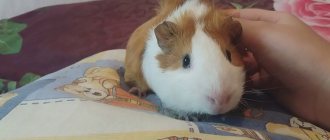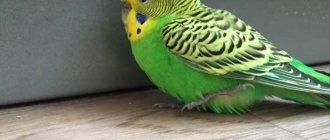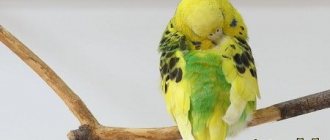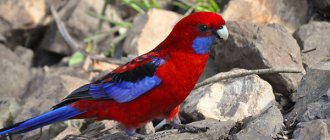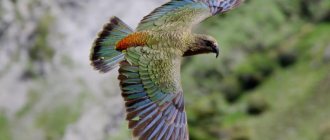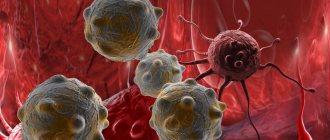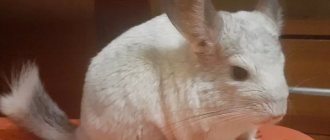- home
- Parrot
- FAQ
04/22/2019 From time to time, the owners of birds notice that their parrot is puffed up and remains in this position for a long time. How can this be explained? Most likely, the hunching itself does not always indicate illness. But there's cause for concern: all is not well with your feathered friend. By doing this, he tries to conserve heat when body temperature drops. It is necessary to carefully examine the bird and take the necessary actions.
Poisoning
The parrot simply loves to taste everything. When he is let out to fly around the apartment, he may eat a piece of a houseplant or piece of paper. You can also be poisoned by medicine forgotten in the room. If after a walk your pet sits indifferent to its surroundings, you need to examine it. Perhaps you will find the reason why the parrot became ruffled.
Poultry poisoning is possible for the following reasons:
- water and food of poor quality;
- products not intended for parrots;
- eating poisonous plants;
- poisoning by chemical vapors;
- use of toys made of toxic materials.
In case of poisoning, vomiting and diarrhea appear, coordination of movements is impaired, convulsions and even paralysis are possible. In difficult situations, you must immediately contact an emergency veterinarian. Only a specialist can prescribe the correct treatment.
Dangerous symptoms that may accompany a parrot with chills
The parrot's trembling, lethargy and closed eyes may indicate not only its hypothermia. If the cause is illness, then other symptoms will appear within 3 days. It is important to identify them as early as possible.
Clear signs of dangerous diseases:
- a bent leg tucked under the body or a drooping wing indicates dislocations and fractures;
- small purulent or bleeding wounds on the body - may indicate various skin diseases;
- digestive disorders: diarrhea, constipation, vomiting;
- lack of appetite, sleepiness, immobility indicate colds or poisoning;
- baldness with itching and redness of the skin indicates the presence of parasites in the bird;
- trembling with convulsions, loss of appetite, hoarseness, uncharacteristic sounds that the pet makes - this is a cold or goiter.
On a note! If the parrot is crested and trembling, or other dangerous symptoms appear, it is necessary to conduct an examination at a veterinary clinic.
Treatment
If it is not possible to seek the help of a veterinarian, then you can do the following. In case of poisoning by toxic fumes, first of all you need to ventilate the room where the parrot is located. In other cases, liquid drugs with adsorbing action are used. They are introduced into the bird's mouth in a few drops through a pipette or syringe.
Dry preparations, such as activated carbon, are dissolved in clean water until they become semi-liquid. Then 1-2 drops are injected through a medical syringe into the side of the beak. A decoction of flaxseed can be used as a laxative. In case of diarrhea due to dehydration, the patient should be constantly given a few drops of clean water. You can feed liquid baby porridge without milk, often and little by little.
Other manifestations of ill health
Usually, the feathering is accompanied by other signs of the bird’s painful condition: trembling, difficulty breathing, eyes closed as if in pain, and there may be vomiting and diarrhea. The parrot sleeps almost all the time and sits at the bottom of the cage, and not on the perch - he simply does not have the strength to do this.
The ruffled appearance of a parrot makes it clear to the owners that the pet either has a cold, has poisoning, or is in pain for some reason. The reasons for this behavior can be various diseases that develop in birds and can affect any organs: eyes, ears, beak, paws, wings, etc. Various infections and diseases of internal organs are also possible.
Of course, only an ornithologist can determine the specific cause, who, if necessary, will do the necessary tests and examinations to clarify the situation.
Colds
Many parrots are gentle, although quite hardy. But drafts are very harmful to them. Having caught a cold, your pet begins to cough and sneeze. He develops a runny nose and body tremors. He begins to shiver, his breathing quickens, his eyes often close. Then he loses his appetite, and most of the time he sits curled up into a ball. By doing this he tries to protect his warmth. What to do if the parrot gets ruffled and hides its head under its wing?
Why is the parrot unkempt and trembling?
Any changes in your pet's behavior, for example, when he unnaturally spreads his wings, often closes his eyes and sits motionless at the bottom of the cage for a long time, have a reason.
Such conditions can be provoked either by errors in the conditions of maintenance and care, or by illness of the parrot.
No concern
A bird experiences fear - this is the very first thing that comes to mind when you notice that a bird is trembling and twitching its wings. This state is especially typical for those who are in the process of adaptation - the parrot is in your house for the first time and is afraid of everything. Not surprisingly, new people, sounds and environments make him fearful.
During this period, there is no need to frighten him with your constant presence, attempts to play, caress him. Let him get used to the new place. Talk to him in a quiet voice, kindly. If you see that something in the cage irritates your pet (a toy, feeder or sippy cup that is unusual for her), remove them so as not to irritate him even more. Gradually the parrot will calm down and stop shaking.
At this time, you should also not let him out of the cage. Without calmly examining the situation, he may run into a piece of furniture, a mirror or window glass and injure himself.
Sharp and loud sounds can greatly frighten the bird, so do not turn on the TV too loudly and do not speak in a raised voice in the room with the parrot.
Stress can cause the appearance of a new pet in the house (especially if it is a cat or dog), or a small child. They make a lot of noise, frighten with sudden movements, and ineptly holding the bird in their arms. Of course, seeing such neighbors, the parrot begins to tremble. If you see his wings shaking, analyze who or what might have scared him. Explain to your children that pets must be handled with care; they are living beings, not toys.
Treatment
In a room with a parrot, it is advisable to maintain a temperature of about 20–22 degrees. Additionally, an artificial heating lamp is placed next to the cage. Overheating should also not be allowed. You should drink warm water with chamomile infusion with the addition of 1-2 drops of honey or lemon juice. A runny nose is treated with inhalations. If a cold causes complications, antibiotics are used.
It is better to entrust the treatment of your pet friend to a qualified specialist. As a last resort, you can use the advice of online resources. On some forums, veterinarians provide advice. There you can post photos of your sick pet and briefly describe its condition. However, you should not overuse self-medication. You may miss time, because the disease is rapidly progressing.
What does it mean if a parrot sits ruffled?
Parrots are very cheerful and playful pets. They spend all their waking hours in motion. They chirp near the mirror, fly, and have fun with toys.
The activity and curiosity of the bird develops into affection for humans. In most cases, the person responds to the bird in kind, getting a lot of pleasure from spending time together. Beautiful cages, unusual toys, various islands of entertainment - all this makes it possible to observe her playful behavior.
But one day the owner notices a sharp drop in his pet’s playful mood. The bird loses its usual activity; it can sit for a long time on a perch or the bottom of the cage, ruffled. If we exclude diseases, then the state when the parrot is ruffled is a feature of its pastime.
During sleep, the parrot deliberately increases the volume of its plumage to better retain body heat. During the rest period, all physiological processes slow down, and the body loses precious heat. After awakening, the bird returns to active life again.
The parrot is cresting, but this is not caused by illness
When a budgie sits ruffled, this does not necessarily mean that it is sick. It is possible that this is due to stress. This is how a bird can react to an unusual environment or loud music. This shows that he is uncomfortable. If this is not accompanied by signs indicating the presence of a disease, then you can cope on your own.
It happens that a parrot gets cocky because there is not enough daylight in the winter. In this case, you need to use artificial lighting. For this, ultraviolet lamps are used, since there is not enough natural sunlight in the room. This can cause lethargy, stress, and metabolic disorders.
Are there preventive measures?
Despite the fact that parrots are quite unpretentious to their living conditions, they still need comfort and coziness. The homeland of these birds is in countries with hot climatic conditions, for this reason they need the same conditions in captivity. Hypothermia can be fatal for this species of bird; in particular, they can develop kidney disease, which is difficult to treat.
As a preventive measure against the occurrence of any disease, it is to avoid drafts and sudden temperature changes, since they are delicate and sensitive creatures and are so easily susceptible to colds.
They can easily catch an infectious disease from their owners, so if you are sick, do not go near them under any circumstances, most likely they will get infected from you, and it will not be so easy to cure them.
And most importantly, you should not take on the treatment of a parrot on your own, because you will still not be able to provide highly qualified assistance, and you will miss out on valuable time. Due to the fact that the metabolism of parrots is carried out at a high speed, all diseases in them develop extremely quickly. So, don’t be late and save your pet!
Improper feeding
The budgerigar is an active bird, constantly on the move. A healthy parrot jumps from branch to branch, walks along the bottom and pecks grains, tears paper, but it will not sit on the floor of the cage. Then it is not entirely clear why the parrot suddenly began to spend a lot of time below. Probably his paws get tired of clinging to the perch, and it’s more comfortable to sit on the pallet. The reason for this condition is errors in nutrition: excess fatty foods or lack of nutrients.
Obesity in a parrot
You need to feed your pet not on demand, but on time, observing the portion size. If you do not adhere to dietary standards, the parrot will get used to overeating, due to which it will gain excess weight. A heavy body is a load on the legs and wings. An obese bird has difficulty moving and simply feels discomfort.
Monotonous food
On a note! It should also be noted that starvation is one of the reasons for bird weakness. The food may be of poor quality, and the parrot will not get enough of it. In some cases, exhaustion is caused by switching to another food that the pet does not like.
Foreign body
Even a microscopic foreign particle or speck that gets into the eye causes an unbearable desire to get rid of it. A person in a similar situation rubs his “clogged” eye with his hand, and the parrot itches himself against the bars of the cage or other hard objects that are freely accessible.
Sometimes, in an attempt to get rid of a speck in the eye in any possible way, a feathered pet causes even greater damage to the organ of vision than the speck could have caused. Often, in addition to redness, the following is observed: the parrot’s eye has closed, the third eyelid has swollen and fallen out.
What to do, how to help your pet
There are several tips that you can use if your bird’s condition does not cause concern, and the reason for his trembling and pouting is not due to illness:
- wrap a frozen pet in a warm, soft towel and gently hold it close to you, turn on a heating lamp for it - after a while it will warm up and stop shaking;
- if the parrot is trembling due to stress or fear, eliminate the cause of this condition and give the bird time to calm down, talk to it gently, and give it a treat.
All other conditions require medical supervision.
Disease Prevention
It is important to provide your pet with the right living conditions. Everything he has the opportunity to come into contact with must be safe for his health and life.
- For breeds as delicate and small as the budgerigar, it is important that food is always available. Make sure that the products are always of high quality and fresh, and that the diet is varied.
- Monitor air temperature and humidity. The microclimate in your room with birds should be optimal for life (22-25°C).
- Protect your pet from stress.
- Adjust daylight hours, clearly delineating the time of wakefulness and sleep. Lighting lamps and thick fabric will help you with this, with which you can cover the cage with the parrot when it is time for him to rest.
- Remove poisonous plants from the room that the bird can taste, do not place it in the kitchen, do not smoke in the same room as it, and make sure that it does not have access to toxic substances.
- Take care of the hygiene of your pet’s home and himself: regularly clean the tray of the cage, wash and disinfect all equipment.
- Both overeating, which can cause obesity, and undernutrition, which leads to exhaustion, are unacceptable. In the latter case, you need to force-feed the pet with nutritional masses from a syringe without a needle.
- A pet can get an infection from a sick person, so they should limit contact with each other until they have fully recovered.
A shaking and ruffled parrot needs your care and immediate response. By noticing the disease in time and starting to treat it, you give your pet every chance to live a long and happy life with you. Don't deprive him of this opportunity.
Prevention
A tamed bird should be given more attention. The parrot must be kept in a standard cage, avoiding drafts, hypothermia and overheating. In winter, you cannot open the window on which there is a cage with a bird. In sunny weather, you need to keep a towel ready to protect the perroque from the burning rays.
You should not feed your parrot just anything. Professionals have developed special food for different breeds of birds. It is balanced in vitamins and other nutrients. It is necessary to protect your pet from excessive noise and contact with predators. When moving or moving, it is useful to give the anti-stress multivitamin drug “Radostin” - 3 days before and 3 days after the trip.
Radostin
Man is responsible for those he tames. If he is attentive to his pets, they will get sick less.
localvet.ru
Causes
Parrots tremble in the following cases:
- The bird froze. The cage stood on the window; it was opened slightly for ventilation and they forgot to close it.
- Stress. A change of environment, a newcomer, childish pampering, a cat who happens to be nearby are causes of fear. The parrot begins to fluff and can really get sick.
- Pathology. If no additional symptoms are observed, the perroque eats natural food, but is ruffled and trembling, hypovitaminosis can be suspected.
- Additional symptoms indicate the disease:
- sneezing;
- closing the eyes;
- vomit;
- liquefaction of litter.
The detection of at least one of the additional signs is grounds for contacting a veterinarian ornithologist. If no auxiliary symptoms are noted, the perroque owner can try to help the pet on their own.
First aid
If your parrot shows symptoms of illness, you should not use dubious solutions recommended on the Internet. Post-traumatic tremors develop as a result of pain (observed after fractures). If the individual is ruffled and trembling, damage to the wing or lower limb is visually visible, treat the wound, put the “sick” in a box with a soft blanket and take it to the veterinarian. The pet will be grateful to you for your care and attention.
Xerophthalmia
The disease is possible due to a lack of vitamin A in the body or a chemical burn to the eye. Translated from Greek, xerophthalmia means “dry eye.”
Symptoms:
- Cloudiness, drying of the cornea;
- Hardening, desquamation, discoloration of the cornea;
- Deterioration of vision;
- Fear of light;
- Complete or partial absence of pupil constriction in bright light.
Treatment consists of a multivitamin complex with the obligatory presence of vitamin A in the form of drops or injections.
Panophthalmitis
It is expressed in infection of the eyes with viral and bacterial infections.
Subsequently, the disease causes the lenses to become cloudy, the cornea is destroyed, and the tissues become filled with blood. The eyeball protrudes from the orbit, and complete blindness is possible. Panophthalmitis is often a consequence of sinusitis, but sometimes this disease occurs in wavy patients due to injury to the eyeball. Treatment includes antibiotics, vitamin A administration, and topical application of glucose powder.

